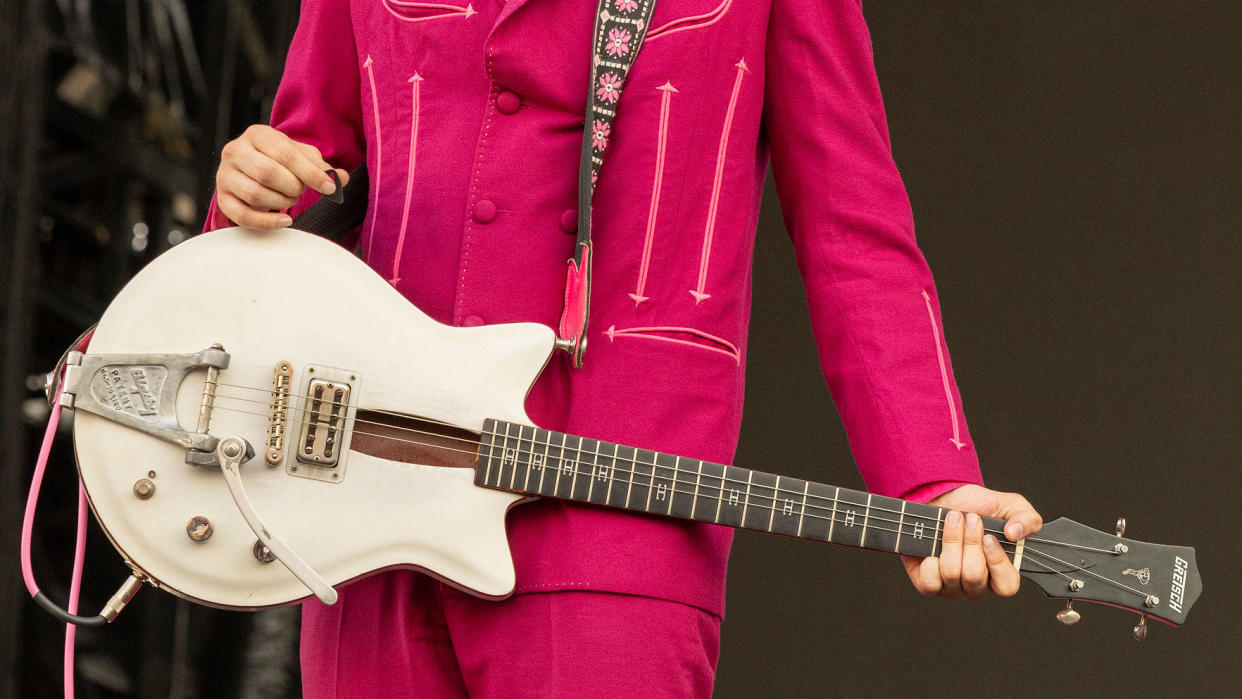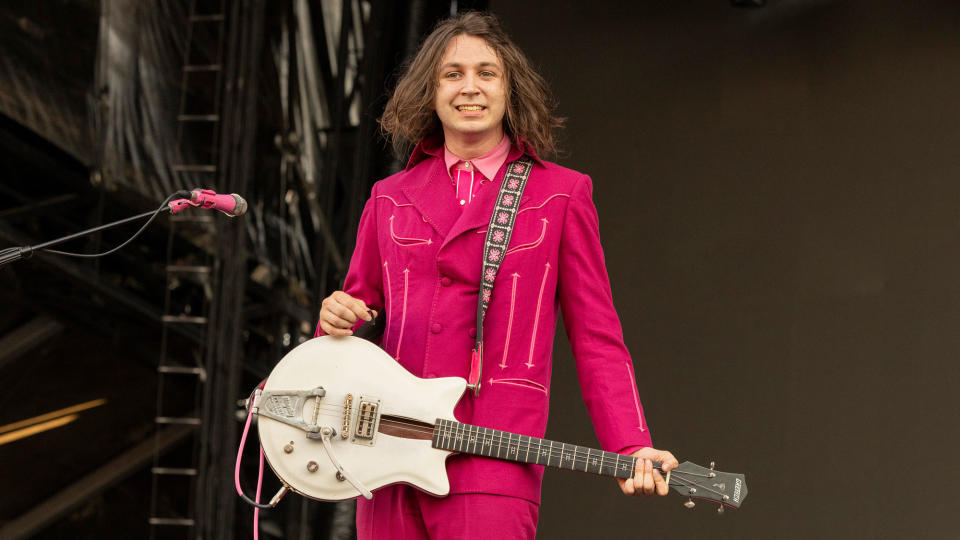10 guitarists who played with missing strings on purpose… and the weird reasons why

- Oops!Something went wrong.Please try again later.
We’ve all been there. The string break. The dreaded string break. That dawning realisation that you’ll have to nip down to Guitar Center or, most likely, order a whole new set of strings from Amazon. The pain. The upheaval. The admin. But what if it didn’t have to be this way?
No, this is not an article about unbreakable strings – but instead about the world of guitarists who play with missing strings on purpose. These luminaries from the worlds of grunge, reggae, metal, new wave and beyond show us that the odd snapped string need not be an obstacle, but an opportunity.
1. Keith Richards
Keith Richards is by far the most notable guitarist to use a restricted string setup. His distinctive five-string chime can be heard on some of The Rolling Stones’ best tracks, including Brown Sugar and Start Me Up.
In the late 1960s, after realising he “was not going to get any better on the sixth string,” Keef started experimenting with open tunings in order to allow him access to new resonances, frequencies and chords that weren’t always possible on the traditional six-string standard tuning configuration. It’s proof that The Human Riff was always keeping his ears open to new sonic possibilities.
2. Bill Orcutt
Bill Orcutt is a giant in the experimental world. After forming then disbanding influential noise rockers Harry Pussy in the 1990s, he went on to cultivate a knotty and uncompromising solo catalogue, as well as many fruitful collaborations.
The defining characteristic of albums such as Odds Against Tomorrow and – fittingly – Why Four Strings? is the four-string guitars he plays. He removes the second and third strings, and the space between the low E and the G gives his tone a distinctive roaring, yowling sound.
The albums he’s made with the Bill Orcutt Guitar Quartet – Music For Four Guitars and Four Guitars Live – show the primal power of what four four-strings can do in unison.
3. Ricky Wilson
Easily one of the most inventive guitarists in new wave, Ricky Wilson of The B-52’s lent his chops to legendary cuts including Rock Lobster, Mesopotamia and Private Idaho. The key to his urgent, snappy, wound-tight style was heavy-gauge strings, Mosrite guitars, bonkers tunings (BADXG#C#, anyone?) and the four and five-string set-ups he favoured.
His tragic death from AIDS in 1985 cut short what should have been a longer and more illustrious career. Indeed, many believe the real sound of The B-52’s died with Wilson.
4. Seasick Steve
With his bushy white beard, baseball cap and beat-up red hollowbody of unidentifiable origin, Seasick Steve is immediately recognisable. Nicknamed ‘The Three-String Trance Wonder,’ the instrument provides the perfect gutbucket backing for his tales of getting booked “for vagrancy” and “sleeping under a bridge.” Add a brass slide and a touch of Tube Screamer overdrive, and Steve really makes the guitar sing.
Whether you believe his backstory or not, Steve posits that this set-up came about through pure expediency, saying: “If you broke a couple of strings and were a baby about it, and said you weren’t going to play, then you didn’t eat.”
5. Kurt Cobain
A devotee of lo-fi music and Leadbelly, Kurt Cobain channeled this appreciation into Nevermind, Nirvana’s breakthrough album. Listen to any of the acoustic guitars and you’ll hear the slack, muted rattle of his dilapidated Harmony Stella.
The guitar frequently went out of tune, had its tuning pegs held in place with duct tape, and had five nylon strings despite being designed for 12 steel strings. You can hear its unique tone most prominently on the moody banger Something In The Way, as well as Polly.
It’s rather endearing that Cobain – who could have owned any high-end acoustic – so often plumped for a $20 model. The moral is simple: if it ain’t broke, don’t fix it.
6. Brushy One String
Brushy One String takes the philosophy of the restricted set-up to the next level. After giving up the guitar as a child, he was reportedly inspired by a dream to play using just a single string.
His Chicken In The Corn video has 64 million views on YouTube. It best demonstrates his unique style, which involves beating out percussion parts on a truly battered acoustic guitar, and thumping his string like a bass.
Brandon Rodriguez, who works for NASA, says in an excellent TED Talk that “constraints aren’t the boundaries of creativity, but the foundation of it” – and Brushy One String is a testament to that.
7. Max Cavalera
Co-founder of metal legends Sepultura and leader of Soulfly, Max Cavelera has been wielding a four-string configuration since two broke off on an early tour, and he never bothered to replace them.
He explained in 2008: “I just do rhythm,” hence the reason he had no need for the other strings. The configuration allows him to emphasise his unfussy power chord-based style, best heard on Sepultura ragers like Roots Bloody Roots and Refuse/Resist.
8. Henri Cash

Henri Cash, guitarist of LA-based rockers Starcrawler, was first inspired to use his three-string configuration after learning guitar via open tunings.
In 2023 he said: “It’s something I’ve done since I was a kid… My dad played guitar, and he used a lot of open tunings. I kind of narrowed that down to the bare essentials and found that three strings were all I needed.”
You can hear the sound of his gorgeous custom-made ‘White Bat’ triple-string on Starcrawler albums such as Devour You and She Said, where it adds a Stonesy swagger to the glam rock backing.
9. The Presidents of the United States of America
Ever heard of a ‘basitar’ or a ‘guitbass’? Enter The Presidents of the United States of America and their Frankenstein’s monster-esque instruments.
Singer and bassist Chris Ballew told Bass Player Magazine in 1997: “I've always been of a disposition to take off strings and find my own way to do things.” He played a guitar strung with two bass strings, while Dave Dederer used a guitar strung with three guitar strings tuned to drop D.
Much like Max Cavalera’s instrument, the guitbass and basitar are machine-tooled for pure impact – an adaptation that suits the raucous energy of albums such as PUSA’s self-titled debut and Love Everybody.
10. Leo Kottke
In a case of the tail wagging the dog, Leo Kottke once sawed off his Martin D-12’s top two machine heads so “it’d fit into a normal case.”
Listening to Kottke’s immaculate fretwork – all sparkling, liquid runs and muscular fingerpicking – you’d be forgiven for thinking it was the output of a different, more pristine instrument. But no: it was a battered 10-string that was taped up like a rugby union prop, with battle scars and an amputation to boot.
That this old war horse is responsible for some of the most thrilling American primitive guitar is yet more evidence that when it comes to strings, less is often more.

